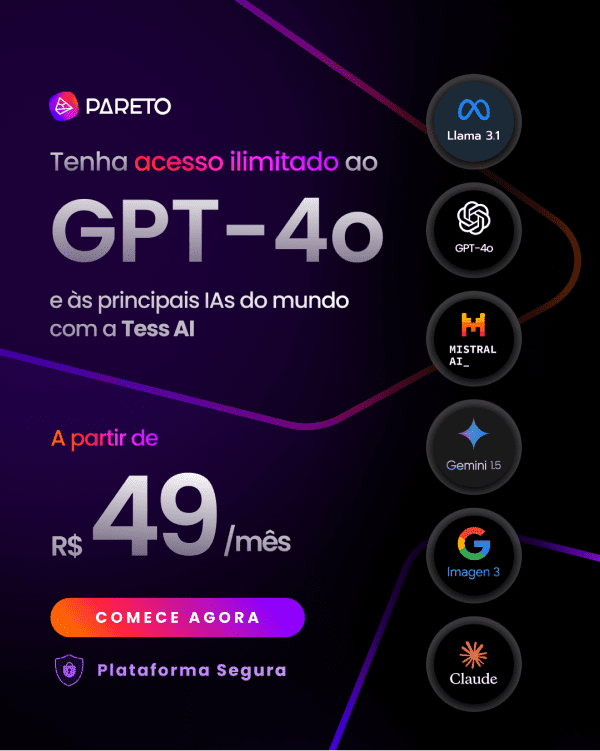Introduction
When managing a Facebook Ads account, most of the time just selecting the desired budget works very well. But what about when we set a budget for the day and it simply doesn't spend? Have we set something wrong or is this normal?
When we're at the stage of creating a set of Facebook Ads, it asks us how much we want to spend. Whether it's per day or per lifetime.
In this article, we'll look at a case study, indicating strategies involving Bid Strategy and Display Method for a Pareto client in the education sector.
How does Facebook Ads work?
First, let's understand how Facebook works with the daily budget. When we put in the daily amount, Facebook takes an average, i.e. it will try to spend approximately what it has set for each day.
Some days, he may realize that you'll get a better return and spend up to 25% more than he set. On other days, they may hold back a little more because they think you won't perform well. But always within the average of what you previously set.
At this point, it's worth noting that it doesn't exceed 7 times the daily amount for the week. For example, if the daily budget is 1 real, the maximum will be 7 reals for the week.
I see, but what's the problem?
When we have a cost target for the month and Facebook's internal optimization doesn't spend even 70% of what we set for the day, what can we do?
In this case, there are a few ways out:
- increase the audience, either by adding more interests or by increasing the geolocation of the ad groups;
- change the bidding strategy of the campaign or ad sets.
In this article, we'll look at the latter with an example from a Pareto client in the education sector.
It has a complex campaign structure separated by units within a radius of 5 km each. Let's go?
Pareto case
As I said earlier, let's use the example of a client in the education sector to explain this strategy better.
His relevant data* is:
- Monthly budget doubled from one month to the next;
- High daily budget, around 3k/day;
- Approximately 30 units distributed throughout Brazil.
It's worth noting here that his conversion method is a registration form. Therefore, the vast majority of users convert on first contact.
Therefore, remarketing audiences deliver very little and the audiences that bring in the most leads are new users.
In addition, we have the geographical limitation of 5km around the units. Since classes are held in person.
How was the solution discovered?
We use the daily budget strategy in the ad groups, with the budget needed per day to meet the cost target at the end of the month.
However, Facebook wasn't spending even 70% of what we had set for the day. To be on the safe side, our Robot increased the budget even more the next day to beat the monthly cost. However, Facebook was still spending the same as on the first day.
With the cost stagnating over the days at the beginning of the month, our robot identified the problem in the ad group bidding strategy and solved it. Now we'll explain to you how it arrived at this solution.
Initial situation
The campaigns had a lowest-cost bidding strategy, with a standard type of placement and the budget controlled on a daily basis.
The balance available for the day was divided between the units, taking into account the size of the city and the number of people in each one.
We had already tested different audiences, but the only ones that worked were:
- Lookalike converters;
- public interest in education.
We were at the height of the fundraising and had no room for new public tests or a Facebook learning period. In addition, we couldn't increase the radius of the units due to the limitation of face-to-face classes.
Final situation
After a few days without a significant increase in the cost of the campaign, our robot decided to change the campaign strategy for some ad sets.
He selected those with a result around 1.5 times below the CPA target. For example, if the target was 30, he switched from ad sets with a CPA of 20.
He made the change in this set because they were more likely to spend the daily budget, since their CPA was lower than ideal and the cost didn't keep up with the daily budget.
The robot continued with the lowest cost strategy, but set a higher bid limit than the historical average and also accelerated the display method.
This bid limit strategy is efficient, but it must be done safely and with calculations behind it. If you set the wrong limit, you could stop running your ads or increase the cost too much as performance declines.
But at the same time, it's a way for us to take complete optimization out of Facebook's hands when they can't achieve our goal.
After this change, the account now spends twice as much as before, and with a slightly higher CPA than before, but lower than desired.
As it was the most important month of the year for the company, the number of leads we were aiming for was very high, almost 3x the number of other months. With this strategy, we were able to beat the target before the end of the month, without having to test new audiences, sticking only with those that really brought results.
Lowest cost strategy with bid limit
In short, Facebook's lowest cost bidding strategy is Facebook's automatic bidding. It tries to give you the lowest possible cost per result.
This strategy is effective when we don't yet know what our real CPA is and we want it to be as low as possible with the budget we have. But in the long term, the lowest possible cost can increase as the competition gets stronger, or as we increase the budget.
When we set a bid limit in this strategy, we are controlling how much Facebook can spend on the conversion event.
So, because we take away the platform's freedom of automatic optimization, we can't set a target lower than what it can deliver. Several articles define how many times more cost per result we need to set the limit at around 2 times more.
Here at Pareto, we do things a little differently and don't use the same factor for all our clients. Instead, we define this value with statistical confidence to guarantee maximum campaign delivery.
After selecting the bid limit for each ad set, we are free to speed up the display method or not.
Display method
The default method comes from the platform, and it will try to deliver the ads evenly throughout the day.
With the accelerated method, your ads will be shown more often and as quickly as possible.
Disclaimer on display methods
The great thing about the standard display method is that it may not use up the entire daily budget. This is because Facebook will try to maximize opportunities at the lowest possible cost.
And that was exactly the problem our client mentioned in this article, which was solved with the change to accelerated.
The accelerated method, on the other hand, will spend your daily budget as quickly as possible and you don't run the risk of leaving money on the table and not achieving your goals. However, two warnings need to be taken into account:
- This strategy usually increases the average cost per impression, cost per click and cost per result;
- It can spend the entire budget for the day before it ends, limiting the ads it runs throughout the day.
This last method is advisable for short periods, such as a live show, lightning promotion, large budgets, etc.
Conclusion
By changing the robot in the campaigns, we were able to beat our enrollment target, and what's more, before the end of the fundraising period.
In the graph below, we can see the increase in daily costs and registrations after changing the strategy in the middle of the month:
Even with the increasing amount spent, the CPA grew slightly, which is to be expected with the accelerated display method.
In addition, all the changes were made with statistical confidence by our robot, which resulted in an average CPA for the month that was lower than the target, and the number of results achieved.
After Pareto's client report, we can now understand a little more about Facebook's lowest cost bidding strategy and how we can apply it in our day-to-day lives. On the other hand, there are many ways to optimize and this was just one of them.
Other ways would be through new audiences, whether from the customer base, Lookalike, interests, fans of the page, among others. Or even by the location of the ad sets.
But we'll talk about that in another article! 🙂 We have this case about optimizing custom audiences on Facebook.
If you want to know more about Facebook and Digital Marketing in general, check out the other articles here on the Pareto Blog!
*some information has been withheld or altered to preserve the client's identity



